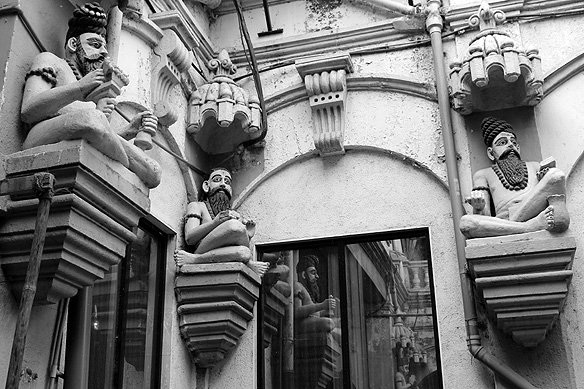Last Sunday I was invited to attend a test walk through Bhuleshwar curated by Khaki Tours. I had just returned to Bombay from a hectic trip to Delhi, and would have given anything to just sleep in. The only thing more tempting was the idea of this walk.
So come 6 am, I found myself wake up to the persistent alarm on my phone, and drag myself, accompanied with my camera to CP Tank, our meeting place. CP Tank, by the way, stands for Cowasjee Patel Tank. It used to be a water tank, built by Parsee philanthropist Cowasjee Patel in 1776, for supplying drinking water in Girgaon. Today, it is an island on VP Road. Dhirubhai Ambani and his family had a home in Bhuleshwar till the 1960s.
For the uninitiated, Bhuleshwar is a predominantly Gujarati neighbourhood just north of the Fort District. Try googling and there is very little you can, if truth be told, lay your hands on about it. Apart from a long list of shops, “Alice in Bhuleshwar” by Kaiwan Mehta and the claim that there are a hundred temples in the vicinity alone, try finding out more, and there is nothing.
Which makes sense, for the 100 temples mentioned are not tourist sites but places of worship for the locals over the past 150-odd years. They are part of their everyday life. Huddled inside Baroque, neo-Gothic and Gujarat styled walls lining the maze of streets overflowing with a populace consumed with either buying or selling, these temples pay homage to gods and goddesses from the Hindu pantheon.
On my walk I met Krishna and Radha, Shiva [the Bholey Ishwar—innocent god—after whom the locality is named, the sun-god, and a five-headed Hanuman. But it was not all about gods and prayers. I also walked into dharamsallas [hostels] which were oases of calm, and a Parsee infirmary for cows, donkeys, hens, birds, dogs, goats, and ducks.
Curious? Come browse my photo essay on bits and bytes of my peek [say 10 percent] into a local [Bhuleshwar] way of life. 🙂

Shri Radha Krishna Mandir. Left: A guardian at the entrance pillars; Right: Detail, the ceiling combines sculpture and painting art forms

Hira Baug or Hirachand Goomanji Dharamsalla (1905), the cover of Kaiwan Mehta’s “Alice in Bhuleshwar” and site of Gandhi’s first speech upon his return to India


A gaushala [cow shelter] and shop selling puja wares at the Madhav Bag and Shri Laxmi-Narayan Temple founded by the Madhavdas Kapole Hindu brothers (1915)

Temples small [in a wall niche, complete with a priest] and grand fill the lanes

Left: The Parsee Bombay Panjrapole (1834) is an animal infirmary and cow ashram, and the last of its kind in the city. Feeding the cows is said to bring good karma; Right: Surya Narayan [Sun god] riding a chariot driven by a seven–headed horse, Shree SuryaNarayan Mandir (1899)

Sages line the walls and roof of the Vedic SuryaNarayan Mandir, some in prayer and others deep in yogic meditation


Top and Left: Krishna Lila on the dome of the sabha mandap and Hanuman as Kastbhanjan at the Shri Swaminarayan Mandir—the oldest Swaminarayan temple in Mumbai (1868); Right: Haldi [turmeric] for prayer ceremonies being sifted at the Bhuleshwar Temple. The neighbourhood is named after this ancient Shiva temple

Head priest at Bhuleshwar Temple: Jovial, chilled out and speaks impeccable English and Hindi ❤

The five-headed Hanuman at the Shri Panchmukhi Hanuman Mandir. The five heads belong to Varaha, Garuda, Hanuman, Narasimha and Hayagreeva, and was a form he took to conquer Ahiravan, brother of Ravana

A sacred altar at the Shri Panchmukhi Hanuman Mandir

Silver effigy of a Marathi woman in local dress stands sentry by the inner sanctum of Sri Krishna Pranami Mandir belonging to a 400-year-old Gujarati sect

Shri Ram Mandir of a by-gone time; It faces the kabutar khana [pigeon-house], now by-gone
– – –
Note: It is easy to get lost in Bhuleshwar in its sea of people crowding the winding narrow lanes. May I suggest if you choose to explore, please do so on a Sunday as I did. Also note that the temples have different darshan timings so you may not be able to see all the idols.
Mumba Devi, the temple after which Mumbai is named is also in Bhuleshwar. I will be writing a separate post on it soon. 🙂


Great writeup !!
LikeLike
Thank you, Yogi Saraswat! 🙂
LikeLike
Great pics! I would really like to visit this place the next time when I am in Mumbai. And thanks for the tip.
LikeLiked by 1 person
Thank you, Arun. May I suggest that when you do, you do it with a curated walk, coz Bhuleshar IS a complete bhulbhulaiya! 🙂
LikeLiked by 1 person
Sure, thanks for the suggestion 🙂
LikeLike
Rama the next i suggest you to explore is all khetwadi’s there are 13 of them.. try visitng those during ganpati.. its so much fun
LikeLiked by 1 person
Thank you for the tip, Bhairavi. Will definitely do them. 🙂
LikeLike